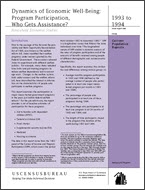Dynamics of Economic Well-Being: Program Participation, 1993-1994, Who Gets Assistance?
Dynamics of Economic Well-Being: Program Participation, 1993-1994, Who Gets Assistance?
Introduction
Prior to the passage of the Personal Responsibility and Work Opportunity Reconciliation Act of 1996, also known as the welfare reform bill, states modified their welfare programs under waivers granted by the Federal Government. These waivers allowed states to experiment with different welfare policies. For example, many states adopted time limits and job training programs to reduce welfare dependence and to encourage work. Changes in the welfare system, both under waivers and the welfare reform bill, have intensified the interest in information on the characteristics of people who participate in welfare programs.
This report examines the participation in major means-tested government programs in the years just before federal welfare reform.1 For the pre-reform era, the report provides a set of baseline estimates of participation for these programs:
- Aid to families with dependent children (AFDC)
- General assistance (GA)
- Food stamps
- Supplemental security income (SSI)
- Medicaid
- Housing assistance
The data in this report come from the 1993 panel of the Survey of Income and Program Participation (SIPP), which covers the period from October 1992 to December 1995.2 SIPP is a longitudinal survey that follows the same individuals over time.3 The longitudinal nature of SIPP enables a dynamic analysis of the rates of program participation and of the amounts of benefits received among people of different demographic and socioeconomic characteristics.
Specifically, this report examines the similarities and differences among various groups in:
- Average monthly program participation in 1993 and 1994 (defined as the average number of people who participated in at least one major means-tested program per month in 1993 and 1994);
- The percentage of people who participated in at least one of these programs during 1994;
- The percentage who participated in at least one program in all 24 months of 1993 and 1994; and
- The length of time participants stayed in the program (the duration of the spell) during 1993 and 1994.
_______________
1 Means-tested programs are those that require income and/or assets of the individual or family to be below specified thresholds in order to qualify for benefits. These programs provide cash and noncash assistance to eligible individuals and families.
2 For each person on the 1993 nine-wave longitudinal file, data are available for up to 36 continuous reference months; the exact number of months depends upon when the person entered or exited the sample. The time period of calendar months covered by these reference months depends on the person’s rotation group. Data for all four rotation groups (the full sample) are available only for the calendar months of January 1993 through September 1995. The Census Bureau will continue to follow the families who participated in the 1992 and 1993 SIPP panels in the Survey of Program Dynamics to provide post-reform longitudinal data.
3 Efforts were made during the life of the panel to follow people who moved to ensure that the sample remained representative of the noninstitutional population of the United States.
Tables
Figures
Others in Series
Publication
Publication
Publication







